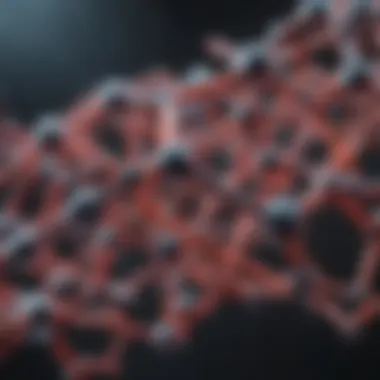Nisin Preparation: Insights into Antimicrobial Techniques


Intro
Nisin is a remarkable antimicrobial peptide that plays a vital role in food safety and preservation. Derived from Lactococcus lactis, this peptide has gained prominence due to its effectiveness against a spectrum of foodborne pathogens. Understanding the preparation of nisin is essential for professionals in the food industry, researchers in microbiology, and anyone interested in food safety.
The journey of nisin preparation is intricate and requires a nuanced approach. It begins with fermentation, where various factors such as pH levels, temperature, and the choice of microbial strains come into play. This section provides an overview of how nisin is produced, the methods used, and the conditions that aid in maximizing its yield. Moreover, the importance of purification methods cannot be overstated, as they directly influence the activity and effectiveness of the final product.
In this exploration of nisin preparation, it's crucial not only to focus on the technical aspects but also to appreciate the broader implications it holds for food safety and public health. Nisin's regulatory acceptance in various countries continues to evolve, influencing its utilization in food products globally. This makes a comprehensive understanding of the factors influencing nisin's yield and activity very pertinent in today’s food industry landscape.
Prolusion to Nisin
Nisin is more than just a buzzword in food preservation; it's a critical player in ensuring the safety and longevity of various food products. Understanding nisin is essential for anyone involved in food science, microbiology, or related fields, as it represents a powerful natural preservative that can mitigate the risks associated with microbial contamination. The relevance of nisin stretches beyond just its functional aspects—it taps into the evolving discourse on food sustainability and safety, making it a topic of great interest.
In this section, we'll explore the fundamental elements of nisin: its definition, its historical backdrop, and the significant role it plays in modern food technology. By dissecting these components, readers can appreciate not only what nisin is but also why it holds a prominent place in food safety.
Definition of Nisin
Nisin, an antimicrobial peptide produced by the bacterium Lactococcus lactis, is classified as a bacteriocin. This classification reflects its ability to prevent the growth of spoilage and pathogenic bacteria. Notably, nisin is known for its efficacy against Gram-positive microorganisms, making it particularly valuable in food preservation. The peptide contains a sequence of amino acids that form a unique structure, which contributes to its antibacterial properties.
From a chemical standpoint, nisin is a polycyclic peptide, which means its structure is characterized by multiple rings formed by covalent bonds. This complexity is what allows it to interact with bacterial cell membranes, ultimately leading to cell death.
Nisin is recognized for being effective at low concentrations, providing significant antibacterial action without compromising the taste and quality of food products.
Historical Context and Discovery
The journey of nisin began in the mid-20th century, a time when food safety became a growing concern worldwide. Discovered in 1928 by a group of researchers in the Netherlands, nisin gained traction as a natural preservative. Initially, it was isolated from Lactococcus lactis cultures derived from dairy products. The discovery of its antibacterial properties sparked interest within the food industry as a potential solution to food spoilage and safety issues.
Over the years, extensive research has validated nisin as a safe and effective preservative. In 1988, the U.S. Food and Drug Administration (FDA) recognized nisin as a Generally Recognized As Safe (GRAS) substance, paving the way for its widespread use in commercial food products. This acceptance marked a significant milestone, as nisin began to be utilized not only for its preservative qualities but also for its potential to enhance food safety across various applications.
In summary, nisin's historical journey underscores its importance in the realm of food preservation, representing a blend of scientific discovery and practical application. Its unique properties and benefits have ushered it into several industries, leading to ongoing research and interest in its potential future uses.
Chemical Structure of Nisin
Understanding the chemical structure of nisin is pivotal to comprehending its functionality as a food preservative. Nisin, a type of lantibiotic peptide, exhibits unique characteristics that confer its antimicrobial properties. The specific arrangement of its amino acids and the presence of unusual residues make this compound distinct among its peers. The molecular architecture not only contributes to nisin’s stability but also plays a crucial role in its interaction with microbial membranes.
Molecular Composition
Nisin is primarily composed of 34 amino acids and is structured in such a way that it forms a stable ring structure. This ring consists of the residues that tightly pack together, stabilized by disulfide bonds. Such a formation is not merely decorative; it enhances the molecule's resistance to proteolytic enzymes, which can significantly affect its efficacy during processing and storage.
In simpler terms, think of nisin like a little fortress. It's built with bricks (amino acids) that are tightly fitted and reinforced, allowing it to withstand attacks from various external forces that would break it down. This stability is crucial in industrial applications where durability in food products is key. The presence of unusual amino acids, like lanthionine, is also critical. These unique components heighten nisin's antimicrobial capabilities, as they facilitate interactions with target bacteria.
"The stability of nisin’s structure is crucial for its long-lasting effectiveness against microorganisms."
Mechanism of Action
The mechanism through which nisin exerts its antimicrobial effects is intricate but understandable. Nisin targets the lipid bilayer of bacteria. It essentially latches onto the bacterial membrane, disrupting its integrity. Once it binds, it forms pores, which leads to leakage of cellular contents and, inevitably, cell death.
This action can be likened to a key that unlocks a door. In this case, nisin is the key that opens up the bacterial membrane, allowing all the essential inner workings to spill out, making it impossible for the bacteria to survive.
The interaction specificity is quite impressive too. Nisin doesn't just attack any random bacteria; it selectively targets Gram-positive bacteria, which are often more susceptible to such disruption.
The efficacy of nisin can vary based on environmental factors, like pH and temperature, which further influence its action. For instance, low pH levels can enhance nisin's antimicrobial potency because acidic conditions can weaken the bacterial defenses, making it much easier for nisin to do its job.
In summary, grasping the chemical structure and mechanism of action of nisin delves into the realms of molecular biology and food science. This understanding provides a foundation for its application in food preservation, ensuring that it remains a point of interest in both academic and practical circles.
Significance in Food Preservation
The preservation of food has been an age-old challenge for humanity. As we seek to extend the shelf life of our meals while keeping them safe for consumption, substances like nisin have emerged as pivotal players in the food preservation game. This section aims to underscore the importance of nisin not only in enhancing safety but also in maintaining food quality over time.
Role of Nisin in Food Safety
Nisin is a naturally occurring antimicrobial peptide produced by various strains of Lactococcus lactis. Its primary draw is its ability to inhibit the growth of a wide array of bacteria, including some pathogens like Listeria monocytogenes and Clostridium botulinum. When added to food products, nisin acts effectively at low concentrations, which is one of its most significant advantages.
The mechanism of action involves binding to specific components in the bacterial cell membrane, disrupting its integrity and leading to cell lysis. This ensures that harmful bacteria are kept at bay, making the food safer for consumers. Moreover, nisin does not simply work in isolation; it can enhance the efficacy of other preservation methods, such as refrigeration or vacuum packaging. This synergy can lead to improved food safety profiles, especially in dairy products, meats, and many ready-to-eat meals.
"Utilizing nisin not only increases food safety but also contributes to the broader pursuit of reducing food waste by extending shelf life."


Another significant aspect of nisin's role in food safety is its non-toxic nature. Unlike some synthetic preservatives that raise eyebrows due to potential health concerns, nisin has a long history of safe consumption. Regulatory bodies across countries, such as the U.S. Food and Drug Administration and the European Food Safety Authority, have approved its use, which reassures consumers that food preserved with nisin is safe and sound.
Comparison with Other Preservatives
When we stack nisin against other common preservatives, its strengths become evident. For instance, traditional chemical preservatives like potassium sorbate and sodium benzoate can deter certain microbial growth, but they might compromise the flavor and color of food. Nisin, on the other hand, has a negligible effect on sensory qualities, allowing for a more natural taste experience.
Moreover, while some preservatives may require higher concentrations to be effective, nisin operates efficiently at lower doses. This not only lowers the cost of usage but also limits any potential negative effect on consumers who might be sensitive to certain additives.
Here’s a quick comparison of nisin’s efficacy against other preservatives:
- Nisin: Effective against a broad spectrum of bacteria, generally regarded as safe, and minimally invasive to food quality.
- Potassium Sorbate: Effective against yeast and molds; however, it can alter the food's taste and is less effective against bacteria than nisin.
- Sodium Benzoate: Commonly used in acidic foods but can be less effective in neutral pH and known to potentially cause adverse reactions in sensitive individuals.
Methods of Nisin Preparation
Understanding the methods of nisin preparation is fundamental not just for scientists, but also for those who are involved in food technology and preservation. The preparations can greatly influence the efficiency, yield, and ultimately the application of nisin in real-world scenarios. Reaching optimal levels of nisin is essential, given its significance as a natural preservative. Focusing on the techniques involved provides deeper insights into their benefits and operational nuances, which can enhance overall productivity and effectiveness in utilizing nisin.
Fermentation Techniques
Fermentation is the cornerstone of nisin production, where specific strains of Lactococcus lactis are often employed. This process allows for the efficient conversion of raw materials into nisin. There are two predominant fermentation techniques: batch and continuous, each of which has its own unique attributes and applications.
Batch Fermentation Process
Batch fermentation is characterized by its simplicity and ease of operation. In this method, nutrients are added all at once, and the fermentation occurs in a closed system. The nisin production cycle begins and ends in this single batch, which is particularly attractive for small-scale operations. This approach provides a robust environment for the microbial culture to thrive.
Key characteristic: This method's straightforwardness makes it a favorite among researchers and small-scale manufacturers.
Benefits:
- Control: Batch fermentation allows for better control over the fermentation parameters, leading to high nisin yield during each cycle.
- Cost-effective: It often requires less sophisticated equipment than continuous systems.
Disadvantages:
- Time-consuming: After a batch is complete, equipment must be cleaned and sterilized, leading to downtime.
- Variability: Each batch can result in variation, making consistent nisin quality a challenge.
Continuous Fermentation Process
Continuous fermentation varies significantly from batch processes. Here, fresh nutrients are continuously supplied, while the culture is constantly harvested at the same rate. This can lead to higher overall productivity and a more stable production environment.
Key characteristic: The ongoing nature of this process can maximize the use of resources and time.
Benefits:
- Consistency: Continuous operations tend to yield a more consistent product due to stable conditions.
- Efficiency: Higher nisin production rates can be achieved, making this method appealing for larger operations.
Disadvantages:
- Complexity: The setup and monitoring of such systems can be more complex and costly.
- Risk of contamination: With the constant input of new materials, the risk of contamination increases, which requires more stringent practices.
Purification Protocols
After fermentation, purification is paramount for isolating nisin from the fermentation broth. There are various purification methods, with filtration and chromatography leading the way. Each technique plays a vital role in ensuring that the final product meets safety standards and quality criteria.
Filtration Methods
Filtration is often one of the first steps in the purification of nisin. This method involves using membranes or filters to separate nisin from cells and other large particles. The benefit of filtration is its relatively simple application and effectiveness in preliminary purification.
Key characteristic: Filtration can quickly clarify the solution, making subsequent steps more effective.
Benefits:
- Rapid process: It can be done relatively quickly, allowing for faster processing of large volumes.
- Cost construction: It generally requires less technical expertise and infrastructure compared to some other methods.
Disadvantages:
- Loss of product: Some yield may be lost during the filtration process.
- Not pure enough: Often requires subsequent purification steps for high purity nisin production.
Chromatography Techniques


Chromatography stands as a more sophisticated method for purifying nisin. This process involves the separation of nisin based on its chemical properties using a stationary phase and a mobile phase. Several types of chromatography can be employed, including ion exchange and affinity chromatography.
Key characteristic: Chromatography allows for the refinement of nisin to achieve higher purity levels, making it suitable for food and pharmaceutical applications.
Benefits:
- High specificity: This method can effectively isolate nisin, resulting in a product of great purity.
- Versatile: Different chromatography techniques can be utilized according to the specific needs of the production process.
Disadvantages:
- Costly setup: High initial investment and operational costs make it less accessible for smaller operations.
- Skill-intensive: Requires skilled personnel for effective implementation and oversight.
Factors Influencing Nisin Production
Nisin production does not occur in a vacuum; several key elements play a significant role in determining the yield and quality of this important antimicrobial peptide. Understanding these factors is essential for optimizing production methods and ensuring the effectiveness of nisin in various applications. By examining nutritional requirements and environmental conditions, we can grasp the complexity of nisin biosynthesis and its practical implications in the food industry and beyond.
Nutritional Requirements
For any microorganism to thrive, the right nutritional balance is crucial, and nisin-producing strains like Lactococcus lactis are no exception. These bacteria require specific substrates for effective growth and optimal nisin production.
- Carbon Sources: Carbohydrates, such as glucose and lactose, are often preferred as they provide readily available energy. When fermented, these sugars not only fuel growth but also influence the peptide yield.
- Nitrogen Sources: A balanced supply of nitrogen from sources like yeast extract, peptone, or amino acids is essential for cell growth and metabolic functions. This nitrogen aids in amino acid production, which is directly correlated to nisin synthesis.
- Minerals and Vitamins: Essential minerals like magnesium and trace elements are pivotal in enzymatic activities involved in metabolic pathways. Furthermore, certain vitamins can provoke growth responses that support higher nisin output.
Inadequate supply of essential nutrients may stunt growth and reduce nisin yield, underscoring the importance of carefully tailored nutrient media in production protocols.
Environmental Conditions
The environment in which nisin-producing bacteria grow has a significant impact on their metabolic activities and nisin production levels. Two of the most critical environmental factors are pH levels and temperature effects, both of which can be finely tuned to optimize production.
pH Levels
The pH of the fermentation medium fundamentally influences nisin biosynthesis. Optimal pH levels ensure more favorable conditions for microbial activity, facilitating effective growth rates. Typically, pH levels ranging from 6.0 to 6.8 are deemed ideal for Lactococcus lactis.
- Key Characteristic: Slightly acidic conditions are often beneficial for promoting enzyme activities essential in nisin synthesis. This environment discourages the growth of spoilage organisms, enhancing bioactivity.
- Unique Feature: A lower pH can amplify the solubility of certain substrates, leading to higher substrate uptake by the microorganisms.
- Advantages/Disadvantages: While optimal pH promotes production, the wrong acidity level can stress the bacterial cells, leading to reduced yields or even cessation of growth. Adjusting the pH can thus be a delicate balance.
Temperature Effects
Temperature plays an equally pivotal role in nisin production. Specific temperature ranges can optimize metabolic rates of the nisin-producing strains, enhancing overall productivity.
- Key Characteristic: Moderate temperatures, typically between 30°C and 37°C, are well-suited for the growth of Lactococcus lactis. These temperatures maximize enzymatic reactions involved in nisin formation.
- Unique Feature: Variations in temperature can directly influence the gene expression related to nisin synthesis. For instance, higher temperatures may initially stimulate growth but can lead to thermal stress that impacts viability adversely.
- Advantages/Disadvantages: While maintaining an ideal temperature is crucial for maximizing nisin output, care must be taken to prevent overheating, which can lead to denaturation of proteins essential for biosynthesis.
"The significance of these factors cannot be overstated; they are integral to not just achieving higher nisin yields but also ensuring the retention of its antimicrobial potency."
Understanding and managing these variables effectively can lead to advancements in food safety and preservation methodologies.
Regulatory Perspectives
In the realm of nisin preparation, understanding the regulatory landscape is not just a nicety; it’s a necessity. The importance of regulatory perspectives allows stakeholders—from researchers to food industry professionals—to navigate the complex framework of safety and compliance. This section sheds light on various facets of nisin's regulatory environment, emphasizing how regulations shape practices and the benefits they bring to market safety and consumer confidence.
Safety Assessment and Approval
The journey towards nisin’s commercial application starts long before it reaches grocery store shelves. A thorough safety assessment and approval process is paramount. Regulatory bodies such as the Food and Drug Administration (FDA) in the United States and European Food Safety Authority (EFSA) play critical roles in evaluating nisin’s safety as a food preservative.
The assessment typically includes:
- Toxicological Studies: These studies evaluate the potential toxicity of nisin on both animals and humans, assessing any adverse effects.
- Efficacy Tests: These tests determine how effectively nisin can inhibit microbial growth, which directly relates to its function in food preservation.
- Allergenicity Studies: Nisin must be evaluated for potential allergic reactions in sensitive individuals, ensuring consumer safety.
Once these assessments are concluded and nisin is deemed safe, it receives regulatory approval, paving the way for its use in food products. This meticulous process highlights the rigorous standards that safeguard public health.
International Regulations
As markets have become increasingly global, the regulatory framework governing nisin also varies across different countries and regions. International regulations establish a baseline for safety and effectiveness but can have unique stipulations based on local governance. For example:
- European Union: The EU has stringent regulations regarding food additives, and nisin is classified as a permitted additive under the EU Regulation 1333/2008. Compliance requires extensive documentation on safety and efficacy.
- United States: Here, nisin holds the status of a GRAS (Generally Recognized as Safe) substance, enabling its use across various food categories with fewer bureaucratic hurdles than other substances.
- Other Countries: Countries like Japan and Australia have their own sets of guidelines harmonized under international standards, ensuring that nisin’s application remains consistent and safeguarded.
Navigating these regulations involves not only understanding the requirements but also adapting to any changes over time. The dynamic nature of regulatory policies demands continuous monitoring and sometimes swift action on the part of the companies involved.


Practical Applications of Nisin
Nisin, a naturally occurring antimicrobial peptide, finds its significance in various domains. The extensive study into nisin has revealed its versatility, particularly in food preservation and healthcare. Its practical applications are not just beneficial but fundamental in numerous industries. By harnessing nisin's natural properties, both food safety and pharmacological treatments can be enhanced, showing nisin's broad spectrum of utility that is worth delving into.
Industry Use in Food Products
In the food industry, the use of nisin acts as a double-edged sword. On one side, it extends the shelf life of products, and on the other, it ensures safety against foodborne pathogens. Here are some important aspects to consider regarding nisin's role:
- Preservation: Nisin is particularly effective against Gram-positive bacteria, such as Lactobacillus and Clostridium botulinum, making it a traditional choice in dairy products, canned foods, and meat products. By inhibiting the growth of these harmful bacteria, it not only preserves the quality of food but also reduces the incidence of food spoilage.
- Natural Alternative: With consumer preferences leaning towards clean labels, nisin serves as a natural preservative. Instead of synthetic additives, nisin's bioactive properties provide an appealing selling point for health-conscious consumers.
- Quality Assurance: The addition of nisin permits manufacturers to keep stricter quality control across production cycles. As nisin works effectively in various pH levels and temperatures, it assures stability in products under different conditions.
However, while integrating nisin into food products, manufacturers must be mindful of its dosage. Overuse of nisin can lead to a flat flavor profile in food, which some consumers may find unappealing. Therefore, finding the right balance in its application is vital for both taste and safety.
Potential in Pharmaceutical Applications
Nisin's promise extends beyond just the food sector into the world of pharmaceuticals. Its effectiveness to combat microbial resistance makes it a topic of growing interest. Below are key points regarding nisin's potential in medicinal applications:
- Antimicrobial Properties: Nisin's ability to disrupt bacterial cell membrane integrity is remarkable. Studies suggest it can target resistant strains of Staphylococcus aureus and even some strains of Enterococcus, which are known for their resilience against conventional antibiotics. This positions nisin as a potential candidate for new antimicrobial therapies.
- Formulation in Therapeutics: As pharmaceutical companies seek innovative solutions to tackle drug-resistant infections, the formulation of nisin into medicinal products is being explored. Its low toxicity and high efficacy hint at possible uses in topical treatments or as an additive in wound care products, enhancing their protective qualities.
- Research and Development: Ongoing research into nisin continues to unravel new potentials, such as its role in enhancing the effectiveness of existing antibiotics. Combining nisin with other agents may help to formulate superior hybrid pharmaceuticals that can act in synergy against pathogens.
In Summary: The diverse applications of nisin, stretching from food safety to future pharmaceutical use, showcase its significant role across industries. As researchers continue to explore and validate these applications, nisin’s versatility may become a cornerstone in combating food safety issues and drug-resistant infections in the years to come.
"Nisin represents a fascinating blend of natural efficacy and modern necessity, signaling a promising future in both food safety and healthcare."
Microbial Interactions
Understanding microbial interactions is crucial when it comes to nisin and its application, especially in the context of food safety and preservation. Nisin acts as a natural antimicrobial agent, targeting specific bacteria that can spoil food or cause disease. This section will explore the significance of these interactions, detailing the specific organisms affected by nisin as well as the broader implications related to resistance development.
Target Microorganisms
Nisin primarily targets Gram-positive bacteria, which are known for their thick cell walls. Some of the notable microorganisms affected include:
- Listeria monocytogenes: This pathogen can lead to serious illness, and nisin's efficacy against it makes it invaluable in food preservation.
- Staphylococcus aureus: Known for causing a variety of infections, inhibitory effects of nisin on this bacterium contribute to food safety.
- Bacillus cereus: Often associated with foodborne illness, nisin can curtail its growth, extending the shelf life of products.
- Clostridium botulinum: The toxin produced by this bacterium is dangerous, and nisin's action against it helps mitigate risks in various foods.
The ability of nisin to inhibit these organisms stems from its action on the bacterial cell wall, leading to cell lysis and death. This mechanism not only helps in ensuring food products remain safe for consumption, but also aids in extending their longevity on the shelf.
Development of Resistance
Despite the effectiveness of nisin, the potential for microbial resistance is a pressing concern. While resistance to nisin is not widespread, instances have been documented, raising questions about the longevity of nisin’s suitability as a preservative. Some of the factors contributing to this phenomenon include:
- Genetic Mutation: Bacteria can acquire mutations that alter their susceptibility to nisin, effectively diminishing its efficacy over time.
- Horizontal Gene Transfer: Genes conferring resistance can spread between bacterial populations, suggesting a need for continuous monitoring.
- Selective Pressure: The continuous use of nisin in food systems can create an environment where only resistant strains survive.
Measures to mitigate the development of resistance include rotating agents in food preservation, combining nisin with other preservatives, and ongoing research to understand resistance mechanisms. It’s essential for researchers and industry professionals to remain vigilant about these dynamics as they can directly impact food safety standards and practices.
"Understanding microbial interactions with nisin not only enhances food quality but also drives research on how to best combat bacterial pathogens."
In sum, the dialogue surrounding microbial interactions in the context of nisin is multifaceted. By effectively targeting harmful bacteria and being aware of resistance issues, the food industry can make informed decisions that promote public health and product longevity.
Future Prospects
The future of nisin research and preparation is a topic that presents itself with substantial promise. As the food industry continues to evolve, so does the demand for effective and natural preservation methods. Nisin not only meets these needs but also provides a compelling perspective on how biosafety can be integrated into food processing. By focusing on the ongoing developments and future possibilities, we can shed light on how nisin can influence various domains, particularly in food safety and public health.
Research Trends in Nisin Studies
Current trends in the study of nisin are increasingly leaning towards bioengineering and genetic modification. Researchers are examining how altering the genetic makeup of nisin-producing bacteria could lead to enhanced yields and improved potency of this antimicrobial peptide. For instance, certain mutations can potentially increase the effectiveness of nisin against a broader spectrum of microorganisms, including some pathogens that have developed resistance to traditional antimicrobials.
Additionally, interdisciplinary collaboration is a burgeoning trend. Researchers from microbiology, food science, and even nanotechnology are pooling together their expertise to innovate applications for nisin. For example:
- Nanocarrier systems are being explored for precise delivery of nisin, enhancing its effectiveness while minimizing dosage.
- Combining nisin with other natural preservatives offers a synergistic effect, potentially leading to lower concentrations required to achieve desired antimicrobial action.
This focus towards research innovation can lead to transformative applications not only in food products but also in pharmaceuticals and biopreservation.
Innovations in Nisin Production
Innovations in production methods have recently garnered attention, particularly with the rising trend of sustainability. Biofermentation techniques are now being refined to optimize nisin yield with minimum waste. For example, utilizing agricultural by-products as growth media for nisin-producing bacteria is gaining traction. This not only reduces costs but also contributes to a more circular economy.
Moreover, advancements in fermentation technology, such as the adoption of continuous fermentation processes, allow for higher efficiency in nisin production. The scalability of these processes can potentially address the market's growing needs without sacrificing quality. Some notable approaches include:
- Utilizing control systems that monitor environmental factors in real-time, ensuring an optimal habitat for bacterial growth.
- Implementing automation in purification stages to streamline the extraction process, making it faster and less labor-intensive.
Through embracing such innovations, the commercial viability of nisin production can dramatically improve.
"As we step forward, the integration of innovative techniques with biological processes will unveil a new realm of possibilities for nisin and its vast applications."
The essence is clear: as research continues to delve deeper, and as production methods transform, nisin has the potential to position itself as a cornerstone of natural food preservation and safety for the future, reinforcing its role in addressing global health challenges.







